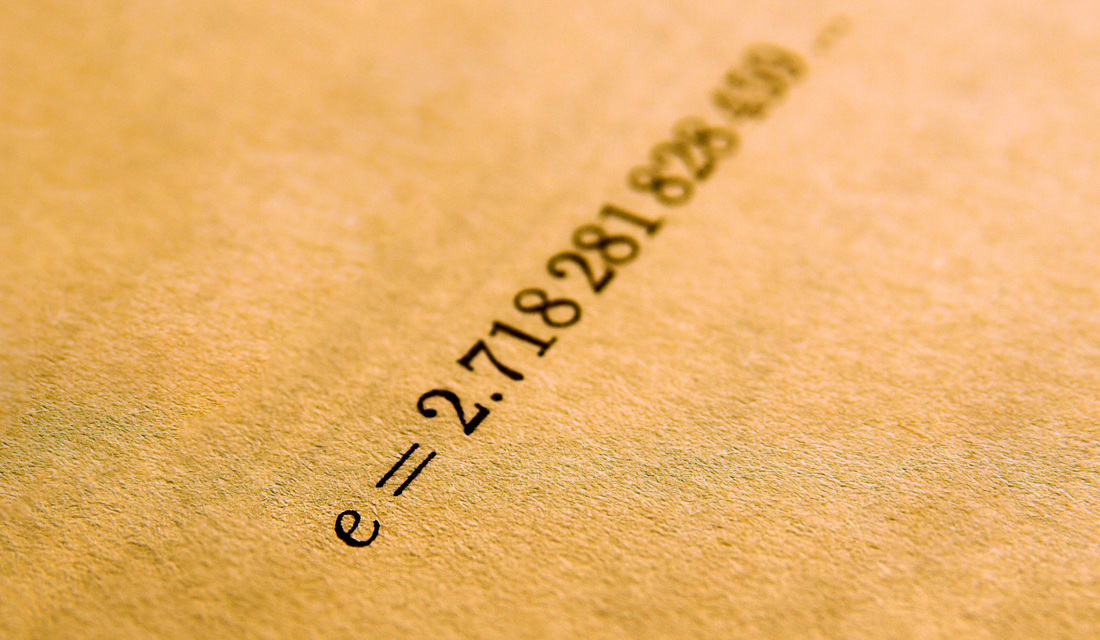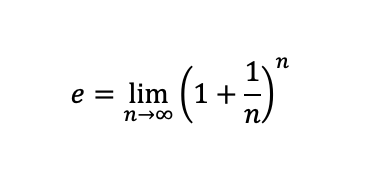SAT® vs. ACT® – Everything You Need to Know in One Easy-to-Follow Guide
Not sure which test to take? Compare SAT® and ACT® test sections, durations, and scoring, and find tips on how to choose the best option for you.

Whether you're curious about the origins of Euler’s number or you are ready for a math challenge, find everything you need in our simple overview with definitions, practical applications, and solved examples.
Don't forget to take the quiz at the end to test your understanding!
Euler's number, denoted as e, is the base for natural logarithms and one of the non-terminating constants we often use in mathematics and science, like Pi (π) which we use in geometry and the Golden Ratio (ϕ) we observe in art.
Euler’s number approximately equals 2.71828.
Even though it was named after the Swiss physicist and mathematician Leonhard Euler, the “discovery” of the constant e is credited to another Swiss mathematician, Jacob Bernoulli.
Jacob Bernoulli encountered the constant 𝑒 in 1683 while studying compound interest. He was interested in understanding how the value of an investment grows when interest is compounded at different frequencies.
Bernoulli started by calculating the future value of an investment with the initial value of 1 unit of currency and an annual interest rate of 100%, compounded at different frequencies. Through his calculations, Bernoulli found that as the compounding frequency increased, the future value of the investment approached approximately 2.718.
This was the first approximation of 𝑒, showing its relationship with continuous compounding and limits.
To date, Euler’s number helps mathematicians, physicists, statisticians, and other scientists explain exponential growth in various phenomena, from population to radioactive decay.
You might wonder how a seemingly abstract mathematical constant like e impacts everyday life. Surprisingly, Euler's number appears in many real-world applications.
It helps us in:
We can model the growth of all kinds of populations, from bacteria in a lab to people in a city, using exponential functions that involve e.
The exponential function we use to explain population growth is:
N (t) = N0 ⋅ ert
Euler’s number helps us describe exponential decay.
Many natural processes, such as radioactive decay and the cooling of objects, follow exponential laws that are best described using e as in the formula:
N (t) = N0 ⋅ e-kt
where:
N0 = The starting value (e.g. the mass of an object or the amount of radioactivity the object has)
e = Euler’s number (approximately 2.71828)
k = The value by which the object decays
r = Time
N(t) = Value after decay
We can also use it to describe other natural phenomena.
Beyond exponential decay, other natural processes like the spreading of diseases and heat transfer, also follow patterns best explained by e.
When calculating compound interest, Euler's number helps us understand how investments grow over time.
For example, if you continuously compound interest, the formula involves e:
A = P ⋅ ert
where:
A = The amount of money after collecting interest
P = The principal (the initial amount of money)
e = Euler’s number (approximately 2.71828)
r = The interest rate
t = The amount of time that has passed
Probability theory is the branch of mathematics that studies random events and phenomena, quantifying uncertainty and predicting the likelihood of various outcomes using mathematical models and principles.
The number 𝑒 also finds applications in probability theory.
For instance, consider a gambler who plays a slot machine that pays out with a probability of 1/n and plays it n times. As n increases, the probability that the gambler will lose all bets approaches 1/e .
Students will usually encounter Euler’s number in high school and college, so you may not ever use it or see how it is derived.
If you are looking for an advanced math challenge, this section is for you!
The main principle for defining Euler's number revolves around the concept of continuous growth and change.
Specifically, is defined using two primary mathematical approaches:
The definition of Euler's number through limits provides insight into its fundamental nature as a mathematical constant. The formula illustrates how e emerges from the concept of continuous growth and compounding over infinitely small intervals of time or events:

Here’s how it works:
The definition of e through limits highlights its role in modeling continuous and exponential growth, compounding interest, and various natural phenomena.
Another important way to define is using an infinite series:
In this series, n! (n signifies factorial) means the product of all positive integers up to n (for example, 3!=3×2×1=6. This series adds up to constant value of e and is used in many areas of mathematics.
The reasoning behind this series lies in the concept of exponential growth and its mathematical representation.
The terms 1/n! become smaller as n increases, but they add up progressively to a specific constant value, e. This means that by adding up more and more terms in the series, we can approximate with increasing accuracy.
This series is fundamental in calculus and other areas of mathematics because it provides a precise method to define e using a sum of infinitely many fractions.
Enjoying the challenge?
Let’s dive into real-world examples to see how helps solve real-life problems. Whether it’s bacteria populations that double over time or investments growing with continuous interest, these examples show how Euler's number is useful in math.
A certain bacteria population doubles every hour. If we start with 100 bacteria, how many will there be after 5 hours, assuming continuous growth?
Using the formula:
N (t) = N0 ⋅ ert
Where:
So,
N(5)=100 ⋅ e0.693⋅5 = 100 ⋅ e3.465 ≈ 100⋅31.95 = 3195
After 5 hours, the bacteria population will be approximately 3195.
Suppose you invest $1,000 at an annual interest rate of 5%, compounded continuously. To find the amount after 3 years, we use the formula:
A = P ⋅ ert
Where:
So,
A = 1000 ⋅ e0.05⋅3=1000 ⋅ e0.15 ≈ 1000⋅1. 1618 = 1161.83
After 3 years, your investment grows to approximately $1161.83.
Create your own user feedback survey
Mathnasium’s specially trained tutors work with students of all skill levels to help them understand and master any K-12 math class, including:
Our tutors work with K-12 students of all skill levels.
Looking for a new challenge? Explore our approach to advanced math tutoring.
Whether you are looking to catch up, keep up, or get ahead in your math class, find a Mathnasium Learning Center near you, schedule an assessment, and enroll today!


Mathnasium meets your child where they are and helps them with the customized program they need, for any level of mathematics.
